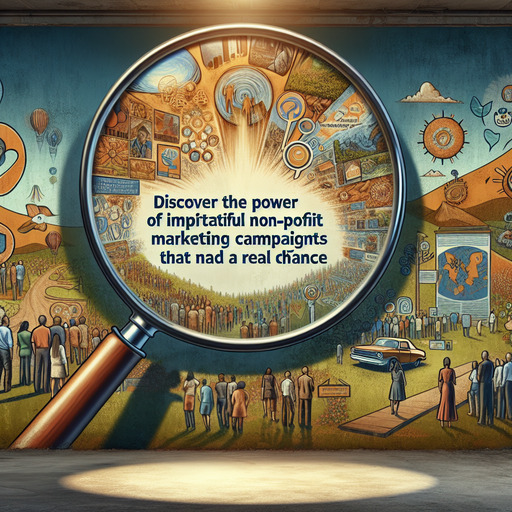
-
Table of Contents
Discover the power of impactful non-profit marketing campaigns that have made a real difference. Learn how these initiatives have transformed communities and inspired change. Explore Now!
Introduction
Non-profit marketing campaigns have the power to drive significant social change, raise awareness, and mobilize resources for critical causes. These campaigns often leverage emotional storytelling, compelling visuals, and strategic outreach to engage the public and inspire action. Successful non-profit marketing efforts can amplify the voices of marginalized communities, influence public policy, and generate substantial financial support. By harnessing the power of media and technology, these campaigns not only highlight pressing issues but also offer tangible solutions, fostering a sense of community and shared responsibility. The impact of these initiatives is evident in the transformative outcomes they achieve, from increased donations and volunteerism to heightened public consciousness and legislative advancements.
Non-Profit Marketing Campaigns That Made a Difference
Non-profit marketing campaigns have the unique challenge of not only raising awareness but also inspiring action and driving change. Over the years, several campaigns have stood out for their creativity, impact, and ability to mobilize communities. These campaigns have not only achieved their immediate goals but have also set benchmarks for future initiatives.
One of the most notable non-profit marketing campaigns is the ALS Ice Bucket Challenge. Launched in 2014, this campaign aimed to raise awareness and funds for amyotrophic lateral sclerosis (ALS), also known as Lou Gehrig’s disease. The campaign’s concept was simple yet highly engaging: participants would dump a bucket of ice water over their heads, share a video of the act on social media, and challenge others to do the same or donate to the ALS Association. The campaign went viral, attracting participation from celebrities, politicians, and millions of individuals worldwide. As a result, the ALS Association raised over $115 million, significantly boosting research funding and public awareness of the disease.
Transitioning to another impactful campaign, the “Like a Girl” initiative by Always tackled gender stereotypes and aimed to empower young girls. Launched in 2014, the campaign featured a video that asked people to perform tasks “like a girl,” revealing the negative connotations associated with the phrase. The video then showcased young girls performing the same tasks with confidence and strength, challenging viewers to rethink their perceptions. The campaign resonated globally, garnering millions of views and sparking conversations about gender equality. It not only elevated the brand’s image but also made a lasting impact on societal attitudes towards girls and women.
Similarly, the “Dumb Ways to Die” campaign by Metro Trains in Melbourne, Australia, used humor and catchy music to promote railway safety. Launched in 2012, the campaign featured animated characters engaging in various dangerous activities, culminating in accidents near trains. The quirky and memorable song quickly went viral, amassing millions of views on YouTube and becoming a cultural phenomenon. The campaign effectively conveyed its safety message, leading to a significant reduction in railway-related accidents and earning numerous awards for its innovative approach.
In another example, the World Wildlife Fund (WWF) launched the “Earth Hour” campaign to raise awareness about climate change and energy conservation. Initiated in 2007, the campaign encouraged individuals, businesses, and landmarks to turn off their lights for one hour to symbolize their commitment to the planet. Earth Hour has since grown into a global movement, with participation from over 180 countries and millions of people. The campaign’s success lies in its simplicity and the powerful visual impact of iconic landmarks going dark, which has helped to keep climate change at the forefront of public discourse.
Moreover, the “Red Nose Day” campaign by Comic Relief has made a significant difference in addressing poverty and social injustice. Launched in the UK in 1988, the campaign uses humor and entertainment to raise funds for various charitable causes. Participants wear red noses and engage in comedic activities, culminating in a televised event featuring celebrities and performances. The campaign has raised over £1 billion, funding projects that improve the lives of vulnerable communities worldwide. Its blend of entertainment and philanthropy has proven to be a winning formula, inspiring similar initiatives in other countries.
In conclusion, these non-profit marketing campaigns demonstrate the power of creativity, engagement, and strategic messaging in driving social change. By leveraging innovative approaches and tapping into the collective consciousness, these campaigns have not only achieved their goals but have also left a lasting impact on society. As non-profits continue to navigate the challenges of raising awareness and funds, these examples serve as a testament to the potential of well-executed marketing strategies to make a meaningful difference.
Q&A
**Question:** What are some examples of non-profit marketing campaigns that made a significant impact?
**Answer:**
1. **ALS Association’s Ice Bucket Challenge (2014):** Raised over $115 million for ALS research and increased awareness globally.
2. **Movember Foundation’s Movember Campaign:** Encourages men to grow mustaches in November to raise awareness and funds for men’s health issues, including prostate cancer and mental health.
3. **Charity: Water’s Birthday Campaign:** Encourages people to donate their birthdays to raise funds for clean water projects, raising millions and providing clean water to thousands.
4. **World Wildlife Fund’s Earth Hour:** A global initiative where individuals and businesses turn off non-essential lights for one hour to raise awareness about climate change, engaging millions worldwide.
5. **Red Nose Day by Comic Relief:** Uses humor and entertainment to raise funds for children in poverty, raising millions annually through televised events and community activities.